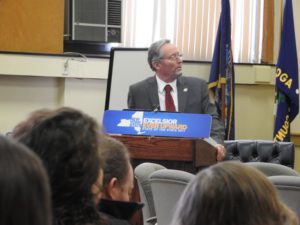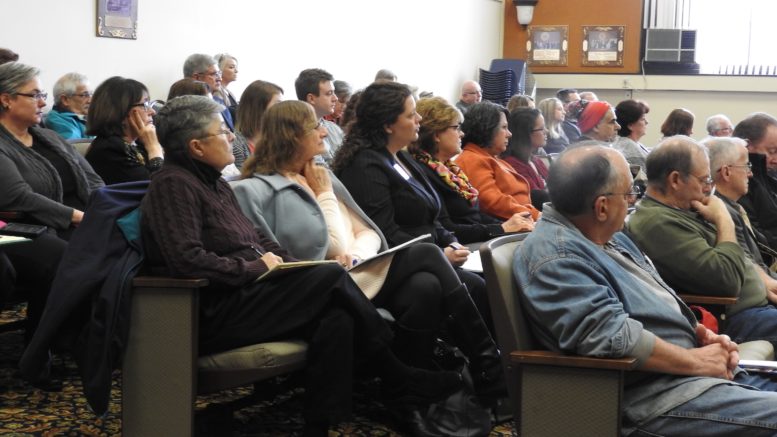
State Commissioner Richard Ball delivered the governor’s State of the State and Proposed Budget to lawmakers and residents at the Tioga County Office Building last Friday. (Photos by Wendy Post)
While Governor Andrew Cuomo was making his rounds across the state to present his State of the State and Proposed Budget, Richard Ball, who serves as New York State’s commissioner of agriculture and markets, arrived in Tioga County, N.Y. to present on behalf of the governor, and to field questions and comments.
The presentation, which was held on Jan. 27 in the Tioga County Legislative Auditorium, drew a good crowd and prompted viable questions from area lawmakers and residents that were in attendance.
The highlights of Governor Cuomo’s Executive Budget include State Operating Funds spending of $98.06 billion in FY 2018 – an increase of 1.9 percent. With Federal funds and capital added in, the spending is anticipated to be $152.3 billion for fiscal year 2018.
Other initiatives include an increase in education aid by $1 billion, for a total increase 4.1 percent, including $961 million for school aid, bringing the new school aid total to $25.6 billion.
The budget increases Medicaid spending under the growth cap (3.2 percent) to $18.3 billion and invests $163 million to make college tuition free for middle-class families at SUNY and CUNY.
The governor’s agenda and proposal caps the price of prescription drugs sold to Medicaid by state review board at no cost, and continues its $20 billion investment to create and preserve 100,000 units of affordable and 6,000 units of supportive housing.
The proposal expands “Buy American” provisions to all procurement over $100,000, protecting the state’s manufacturing and construction sectors; invests $2 billion over five years for the Clean Water Infrastructure Act; supports New York’s middle-class families by doubling New York State Child and Dependent Care Tax Credit; and begins the Middle Class Tax Cut for six million New Yorkers – saving households $250 on average next year and $700 annually when fully effective.
The proposal also extends the tax rate on millionaires – affecting 45,000 taxpayers, with 50 percent being non-residents.
The Executive Budget for Fiscal Year 2018, in its entirety, can be viewed online at www.budget.ny.gov/pubs/executive/eBudget1718/fy1718littlebook/BriefingBook.pdf.
Many of the concerns and questions that came up during Ball’s briefing concerned unfunded mandates, the free college initiative, consolidation of services among municipalities, and farming.
Some in attendance also questioned what might happen if the Affordable Care Act is repealed in its entirety, and what impact it would have on the county.
There were many questions, and few answers.
Commissioner Ball, however, did maintain a focus on land and natural resources in New York. He mentioned veterans as well, stating, “Our veterans are coming back with no opportunities, and farming could be the answer.”
Ball himself operates a sustainable farm and agri-tourism business in Schoharie, N.Y. He noted the growth in microbreweries and other types of ag related production in New York State and talked about the State Fair, along with the 1.1 million that attend it each year.
Some in attendance questioned Hemp farming, and wondered how it would be regulated to ensure that producers would not be growing marijuana as well within their crops.
But unfunded mandates, as in the past, were a major concern to lawmakers in attendance.
Martha Sauerbrey, chair of the Tioga County Legislature, stated that 93 percent of the budget is mandates. “We don’t need things shoved down our throats,” said Sauerbrey of this continued frustration. Mayor Jim Tornatore, from the Village of Newark Valley, expressed the same concerns.
Others in attendance, like the county’s treasurer, James McFadden, felt that the governor should offer incentives for municipalities to consolidate services.
On page 85 in the governor’s proposal, New York’s local government assistance programs were highlighted. According to the proposal, the plan will provide general-purpose aid to municipalities, as well as targeted grant programs and incentives for local government efficiency and consolidation actions.
Governor Cuomo describes this initiative, as well as the continued tax cap placed on municipalities, as offering tax relief to homeowners. Now it is up to the individual municipalities to act on these initiatives, and apply for the funding that will assist in consolidation – if the lawmakers choose to do so.



Be the first to comment on "State’s proposed budget presented in Owego"